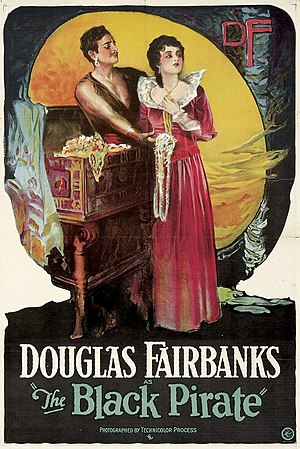The Black Pirate
Jump to navigation
Jump to search
| This article was copied (instead of imported) from the now-deleted Miraheze wikis. |
| The Black Pirate | ||||||||||||||||||||||||||
|---|---|---|---|---|---|---|---|---|---|---|---|---|---|---|---|---|---|---|---|---|---|---|---|---|---|---|
This film has been preserved in the National Film Registry in 1993.
| ||||||||||||||||||||||||||
 | ||||||||||||||||||||||||||
|
The Black Pirate is a 1926 American silent action adventure film shot entirely in two-color Technicolor about an adventurer and a "company" of pirates. Directed by Albert Parker, it stars Douglas Fairbanks, Donald Crisp, Sam De Grasse, and Billie Dove. In 1993, The Black Pirate was included in the annual selection of 25 motion pictures to be added to the National Film Registry of the Library of Congress, being deemed "culturally, historically, or aesthetically significant".
Why It Rocks
- The motion picture was filmed entirely in two-strip Technicolor (and it's the first to do so successfully) -- a process still being perfected at the time of its production and release, and the precursor to Technicolor processes that would become commonplace by the 1950s. As a bonus, the two color Technicolor process adds a charmingly antique look to the film.
- For brief context, Herbert Thomas Kalmus founded the Technicolor Corporation in 1915. He devised a two color process that didn't require special projection equipment. The colors captured were reds and greens, each recorded by a camera that would split the optic beam, permitting separate exposures of each color to register onto separate film strips. After a previous failed attempt to do a few length Technicolor film, the process was stalled. Few producers were willing to take a chance with color. Technicolor needed a major personality with sufficient gravitas and reputation to endorse the process. Then Douglas Fairbanks decided to make a pirate picture, and for him it had to be in color, but they made sure the color didn't "dominate the narrative".
- Despite the film having a tight story containing every archetype of pirate tales and no overly complex plot, it was part of the film’s strength. It was a fable, pure and simple, a Howard Pyle inspired tale of buried treasure chests, heroes forced to walk the plank and the likes.
- Only seventy-eight intertitles were required to tell the story, leaving the rest of the film dedicated to the performances, story line and stunts and yet it still manages to be not to difficult to follow for viewers.
- Douglas Fairbanks is at the absolute top of his game in this swashbuckling tour-de-force as the titular Black Pirate. He was known as the king of silent action adventure pictures for a very good reason.
- The rest of the actors provide amazing performances as well. Stand outs are Anders Randolf and Sam de Grasse who are impeccable as two of the pirate commanders and they really steal the show.
- The stunts within the film are among the most exuberant and thriller sequences in all of silent film. One in particular that's worth mentioning would be what may be Fairbanks' most famous stunt -- the knife-in-the-sail slide, in which our hero travels from the main topsail yardarm to the main yardarm by means of plunging a dagger into the topsail and slicing his way down.
The Only Bad Quality
- As mentioned above, Fairbanks was more interested in capturing the adventure and excitement of the pirate genre, and less interested in telling a story. For example, it's never really explained how or why The Black Pirate became the man he was, or how he ends up protecting a princess from being sold to slavery. The action seems to take precedence over plot and plausibility.
The Film (inside the public domain)
Trivia
- As mentioned above, The Black Pirate is the first two-strip technicolor feature film.